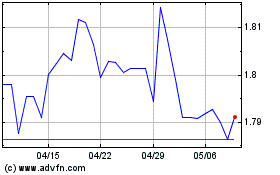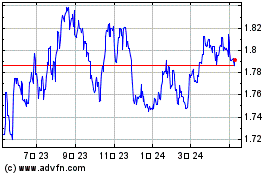Euro Rises On ECB Stimulus Tapering Fears
The euro strengthened against its major counterparts in the
early European session on Tuesday, as the European Central Bank's
QE reduction to 30 billion euros a month took effect and comments
from ECB board member Benoit Coeure sparked fears over the
withdrawal of stimulus.
There was a strong chance that the bank's 2.55 trillion euros
asset purchase programme would not be extended again when it
expires in September, Cœuré told in an interview with Caixin
Global, which was conducted on December 17 and published over the
weekend.
Should inflation turned out to be higher than currently
expected, the bank is ready to respond with several instruments, he
told.
Final data from IHS Markit showed that Eurozone manufacturing
sector activity grew the most since the survey began in
mid-1997.
The factory Purchasing Managers' Index improved to 60.6 in
December, in line with flash estimate, from 60.1 in November.
This was the highest score since mid-1997 and identical to the
flash estimate published on December 14.
The currency has been trading in a positive territory against
its major rivals in the Asian session, with the exception of the
pound.
The 19-nation currency climbed to 0.8918 against the pound, its
strongest since November 28, 2017. If the euro extends rise, 0.91
is likely seen as its next resistance level.
Data from IHS Markit showed that the U.K. manufacturing activity
growth eased more than expected in December.
The IHS Markit/Chartered Institute of Procurement & Supply
Purchasing Managers' Index fell to 56.3 from November's 51-month
high of 58.2.
The common currency firmed to near a 4-month high of 1.2078
against the greenback, compared to 1.2005 hit late New York Friday.
The euro is likely to challenge resistance around the 1.23
region.
The euro that ended Friday's trading at 1.1685 against the franc
advanced to a 5-day high of 1.1728. The euro is seen finding
resistance around the 1.20 mark.
The single currency strengthened to near a 2-week high of 1.6961
against the kiwi, 11-day highs of 1.5411 against the aussie and
1.5141 against the loonie, from its early 4-day lows of 1.6868 and
1.5323 and an early low of 1.5056, respectively. Continuation of
the euro's uptrend may see it challenging resistance around 1.72
against the kiwi, 1.56 against the aussie and 1.53 against the
loonie.
The euro hit more than a 2-year high of 135.63 against the
Japanese yen, from an early 4-day low of 135.15 and held steady
thereafter. The pair ended last week's deals at 135.16.
Looking ahead, Markit's U.S. final manufacturing PMI for
December is set for release in the New York session.
Euro vs NZD (FX:EURNZD)
FXチャート
から 3 2024 まで 4 2024

Euro vs NZD (FX:EURNZD)
FXチャート
から 4 2023 まで 4 2024
